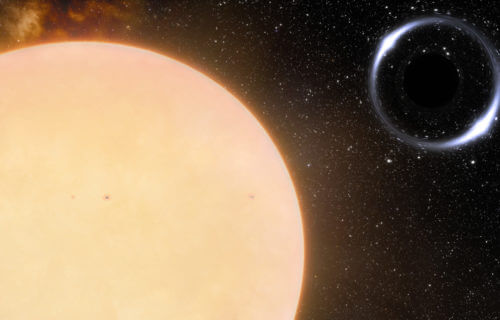TUCSON, Ariz. — Black holes have long been one of astronomers most fascinating areas of research to study. In a recent development, using the Gemini North telescope on Hawaii, astronomers have successfully discovered the closest-known black hole to planet Earth, making it the first clear detection of one in the Milky Way.
There have been previous “findings” before of dormant black holes, but these were disqualified not long after as a companion star was present.
“While there have been many claimed detections of systems like this, almost all these discoveries have subsequently been refuted. This is the first unambiguous detection of a Sun-like star in a wide orbit around a stellar-mass black hole in our Galaxy,” explains lead author Kareem El-Badry, an astrophysicist at the Center for Astrophysics | Harvard & Smithsonian and the Max Planck Institute for Astronomy, in a statement.
The team began by identifying the system as possibly having a black hole by conducting data analysis from the European Space Agency’s Gaia spacecraft. The spacecraft was able to successfully capture irregularities in the movement of the companion star that would be caused by a gravitational pull that isn’t clearly able to be seen. It’s particularly difficult to identify black holes in a dormant state as they easily blend in with surroundings, and thus are not easily seen.
To have a clearer view, the team used the Gemini Multi-Object Spectrograph instrument on Gemini North, which was able to record the velocity of the companion star as it orbited the black hole. It also provided an accurate measurement of the orbital period. Through this, the researchers were able to more confidently identify a ginormous black hole thats 10x as large as the sun.
“Our Gemini follow-up observations confirmed beyond reasonable doubt that the binary contains a normal star and at least one dormant black hole,” says El-Badry. “We could find no plausible astrophysical scenario that can explain the observed orbit of the system that doesn’t involve at least one black hole.”
This, of course, peaked the curiosity of the astronomers. They turned their attention to attempting to explain how Gaia BH1 black hole even came into existence. The progenitor star that later turned into this hole would have been at least 20 times the size of our sun, meaning it only would’ve lived for a few million years. If both stars formed at once, the progenitor star would’ve engulfed the other before it could become like the sun.
Scientists are still unclear as to how the star survived this event, but current theoretical models suggest that the solar-mass star should be on a tighter orbit than what is seen. “It poses many questions about how this binary system was formed, as well as how many of these dormant black holes there are out there,” El-Badry states. While this research is a great discovery, it arguably poses even more questions about how the companion star is as typical as it is, given the events.
Above: This animation shows a Sun-like star orbiting Gaia BH1, the closest black hole to Earth, located about 1600 light-years away. Observations by Gemini North, one of the twin telescopes of the International Gemini Observatory, operated by NSF’s NOIRLab, were crucial to constraining the orbital motion and hence masses of the two components in the binary system, allowing the team to identify the central body as a black hole roughly 10 times as massive as our Sun. (Credit: T. Müller (MPIA), PanSTARRS DR1 (K. C. Chambers et al. 2016), ESA/Gaia/DPAC)
The findings are published in the Monthly Notices of the Royal Astronomical Society.
